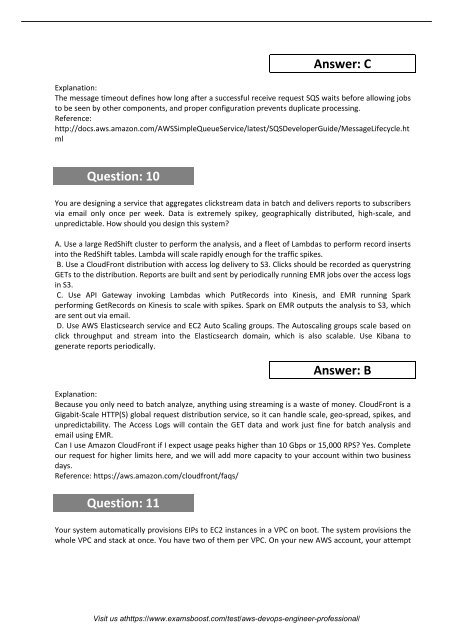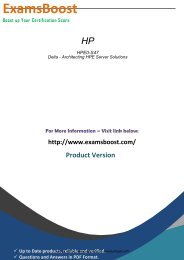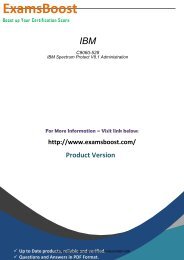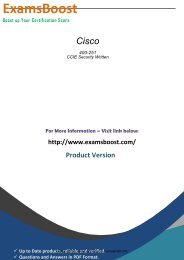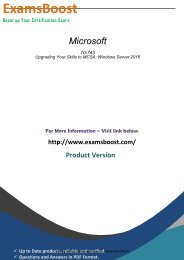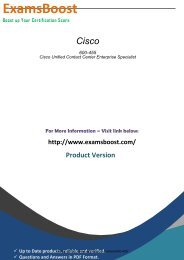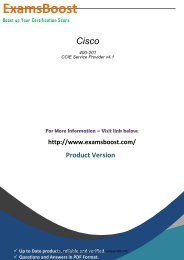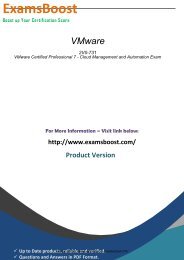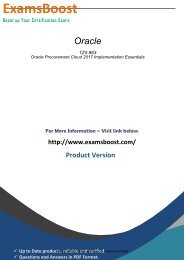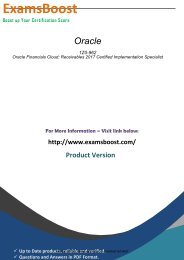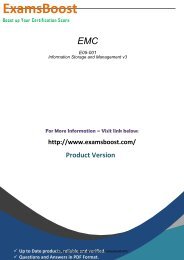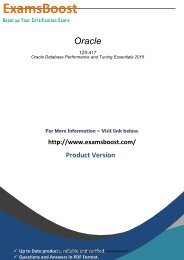AWS-DevOps-Engineer-Professional Coaching Kits
Study kits and preparation materials provided by us for AWS-DevOps-Engineer-Professional Test are authorized by the professionals and industry experts. You can easily pass your certification test with our brain dumps and PDF sample questions. For more info please visit here: http://www.examsboost.com/test/AWS-DevOps-Engineer-Professional/
Study kits and preparation materials provided by us for AWS-DevOps-Engineer-Professional Test are authorized by the professionals and industry experts. You can easily pass your certification test with our brain dumps and PDF sample questions. For more info please visit here: http://www.examsboost.com/test/AWS-DevOps-Engineer-Professional/
Create successful ePaper yourself
Turn your PDF publications into a flip-book with our unique Google optimized e-Paper software.
Answer: C<br />
Explanation:<br />
The message timeout defines how long after a successful receive request SQS waits before allowing jobs<br />
to be seen by other components, and proper configuration prevents duplicate processing.<br />
Reference:<br />
http://docs.aws.amazon.com/<strong>AWS</strong>SimpleQueueService/latest/SQSDeveloperGuide/MessageLifecycle.ht<br />
ml<br />
Question: 10<br />
You are designing a service that aggregates clickstream data in batch and delivers reports to subscribers<br />
via email only once per week. Data is extremely spikey, geographically distributed, high-scale, and<br />
unpredictable. How should you design this system?<br />
A. Use a large RedShift cluster to perform the analysis, and a fleet of Lambdas to perform record inserts<br />
into the RedShift tables. Lambda will scale rapidly enough for the traffic spikes.<br />
B. Use a CloudFront distribution with access log delivery to S3. Clicks should be recorded as querystring<br />
GETs to the distribution. Reports are built and sent by periodically running EMR jobs over the access logs<br />
in S3.<br />
C. Use API Gateway invoking Lambdas which PutRecords into Kinesis, and EMR running Spark<br />
performing GetRecords on Kinesis to scale with spikes. Spark on EMR outputs the analysis to S3, which<br />
are sent out via email.<br />
D. Use <strong>AWS</strong> Elasticsearch service and EC2 Auto Scaling groups. The Autoscaling groups scale based on<br />
click throughput and stream into the Elasticsearch domain, which is also scalable. Use Kibana to<br />
generate reports periodically.<br />
Answer: B<br />
Explanation:<br />
Because you only need to batch analyze, anything using streaming is a waste of money. CloudFront is a<br />
Gigabit-Scale HTTP(S) global request distribution service, so it can handle scale, geo-spread, spikes, and<br />
unpredictability. The Access Logs will contain the GET data and work just fine for batch analysis and<br />
email using EMR.<br />
Can I use Amazon CloudFront if I expect usage peaks higher than 10 Gbps or 15,000 RPS? Yes. Complete<br />
our request for higher limits here, and we will add more capacity to your account within two business<br />
days.<br />
Reference: https://aws.amazon.com/cloudfront/faqs/<br />
Question: 11<br />
Your system automatically provisions EIPs to EC2 instances in a VPC on boot. The system provisions the<br />
whole VPC and stack at once. You have two of them per VPC. On your new <strong>AWS</strong> account, your attempt<br />
Visit us athttps://www.examsboost.com/test/aws-devops-engineer-professional/


